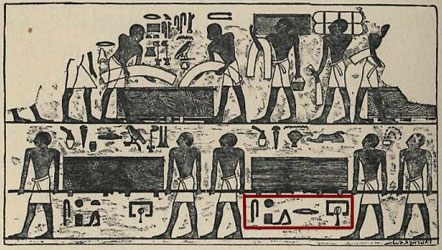Translating verbs can be a little tricky. It is necessary to distinguish the stem of the verb and then check the ending to find out whether the verb is; past, present or future tense; masculine or feminine; and singular or plural.
There are four classes of verb; strong verbs, doubled or doubling verbs, weak verbs and extra weak verbs.
Strong verbs are named as such because the stem of the verb often remains unchanged for different tenses. This can make them rather hard to translate correctly. Although doubled verbs classically end with two identical consonants. In some tenses only one of these consonants is used, which can help with translation.
Strong Verbs

sdjm – hear
Doubling verbs end in a double consonant so they are easy to spot.
Doubled Verbs



mAA – see
Weak verbs end in a “weak consonant” (“i” or “w”) vary more noticeably in each form, making translation easier. However, the last sign (the weak consonant) of the stem was not always written and so is generally not transliterated or is written in brackets.
Weak Verbs


mr(i) – love
Extra weak verbs also end in a weak consonant and vary significantly in different forms. Again, the last sign (the weak consonant) of the stem was not always written and so is generally not transliterated or is written in brackets. Extra weak verbs can also be depicted with the first consonant missing. For example, the stem of the verb “to give” can be written as “rd(i)” or “d(i)”.
Extra weak verbs


rd(i) – give, place
Infinitives
The infinitive is usually translated as “to …” or “…ing” (i.e. “to walk”, “singing”). The strong verb stem is unchanged, doubling verbs include the both final consonants and both types of weak verb stem have the added ending “t”. Extra weak verbs are sometimes depicted without the first consonant.
Strong verbs



sDm – to hear, hearing
Doubled verbs



mAA – to see, seeing
Weak verbs


mrt – to love, loving
Extra weak verbs




rdit – to give, giving, to place, placing
dit – to give, giving, to place, placing
Infinitives often appear in captions beside pictures which depict the action being described in the text. As a result, infinitives sometime appear without the determinative of the verb because the context makes the meaning clear. In the highlighted section of text below, the determinative (the two joined legs) has been retained. The caption says “shp r pr Hd” – conveying to the white storehouse

Hieroglyphs Resources
- Gardiner’s sign list
- Single consonant signs
- Phonograms, Logograms and Determinatives
- Nouns and Prepositions
- Relative Forms
- Pronouns
- Word Order
- Verbs forms
- Past and Present tense
Copyright J Hill 2010